Short-Spacings
The ALMA instrument is composed of:
The figures below illustrates how this combination will be used to recover all spatial frequencies, and therefore provide the best possible images, especially when observing extended sources.
More details can be found in the wide-field imaging lecture from the last IRAM millimeter-interferometry school; see also the report "Single-dish observation and processing to produce the short-spacing information for a millimeter interferometer" by N.Rodriguez et al.
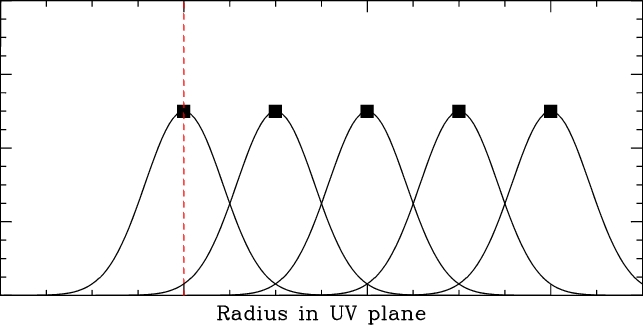 This figure illustrates the tranfert function of an interferometer, in
a 1-D uv plane. The Y axis is arbitrary. The black square are the
position of the measured points in the uv plane. An interferometer
cannot sample all spatial frequencies: the shortest
baseline distance defines the shortest spatial frequency that is
measured (vertical red line). Each measurement is actually a
local average of the visibilities, weighted by the transfert
function of each individual antenna (here approximated by Gaussian).
This figure illustrates the tranfert function of an interferometer, in
a 1-D uv plane. The Y axis is arbitrary. The black square are the
position of the measured points in the uv plane. An interferometer
cannot sample all spatial frequencies: the shortest
baseline distance defines the shortest spatial frequency that is
measured (vertical red line). Each measurement is actually a
local average of the visibilities, weighted by the transfert
function of each individual antenna (here approximated by Gaussian).
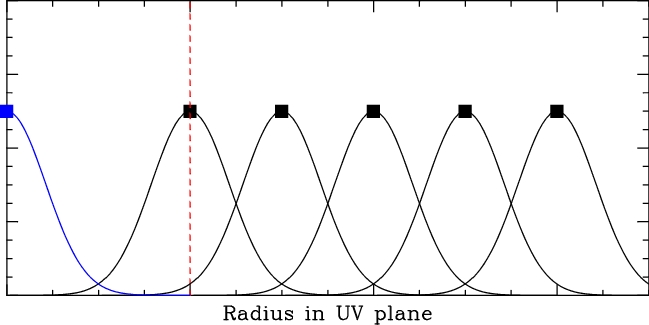 Adding the measurement of a single-dish antenna of the same diameter as
that of the array antennas (blue curve) provides the zero-spacing
point. This is usually not enough to fill the central gap in the uv
measurements.
Adding the measurement of a single-dish antenna of the same diameter as
that of the array antennas (blue curve) provides the zero-spacing
point. This is usually not enough to fill the central gap in the uv
measurements.
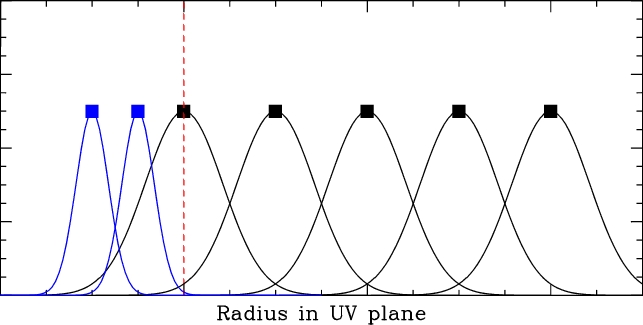 An array composed of smaller antennas (blue curves) can sample shorter
baselines (short-spacings). But this does not provide the
zero-spacing measurement.
An array composed of smaller antennas (blue curves) can sample shorter
baselines (short-spacings). But this does not provide the
zero-spacing measurement.
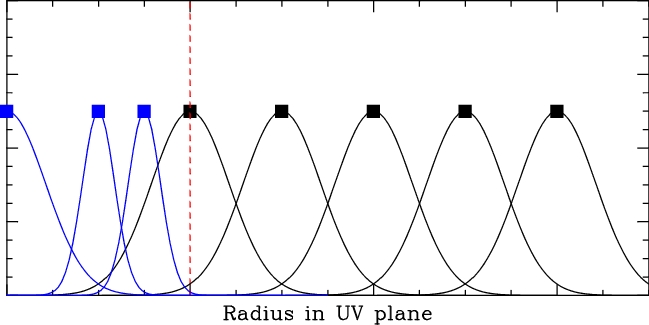 A good solution to fully sample the uv plane is to combine the two
previous experiences: the short-spacings are measured by an array of smaller
antennas, while the zero-spacing is measures by a single-dish antenna
of the same diameter as the antennas of the main array. This is
what is done when using ALMA+ACA+the single-dish antennas.
A good solution to fully sample the uv plane is to combine the two
previous experiences: the short-spacings are measured by an array of smaller
antennas, while the zero-spacing is measures by a single-dish antenna
of the same diameter as the antennas of the main array. This is
what is done when using ALMA+ACA+the single-dish antennas.
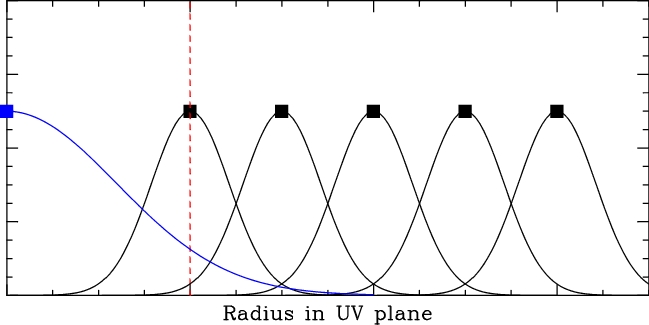 Another solution to fully sample the uv plane is to combine the
interferometric data with the measurements obtained with a single-dish
antenna whose diameter is larger than that of the array antennas:
the single-dish provides in that case both the zero- and the
short-spacings. This is what is done when combining IRAM PdBI
and 30 m data.
Another solution to fully sample the uv plane is to combine the
interferometric data with the measurements obtained with a single-dish
antenna whose diameter is larger than that of the array antennas:
the single-dish provides in that case both the zero- and the
short-spacings. This is what is done when combining IRAM PdBI
and 30 m data.
- An array of 50 12-m antennas (64 antennas were planned initially).
- An array of 12 7-m antennas, that form the ALMA Compact Array (ACA). The ACA is being built to measure the short-spacing information. It can also be used as an independant instrument, or to make additional (calibration) measurements.
- 4 12-m antennas equipped for single-dish measurements, i.e. with a wobbling secondary. These antennas will be used to measure the zero-spacing.
The figures below illustrates how this combination will be used to recover all spatial frequencies, and therefore provide the best possible images, especially when observing extended sources.
More details can be found in the wide-field imaging lecture from the last IRAM millimeter-interferometry school; see also the report "Single-dish observation and processing to produce the short-spacing information for a millimeter interferometer" by N.Rodriguez et al.





